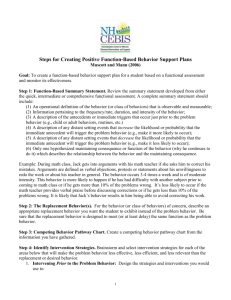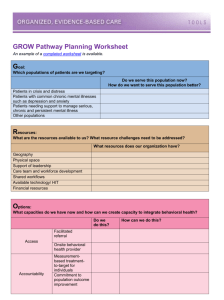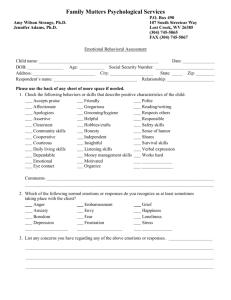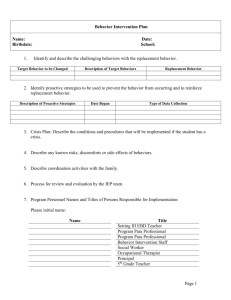Functional Behavioral Assessment 10/19/2012 Today’s Objectives
advertisement
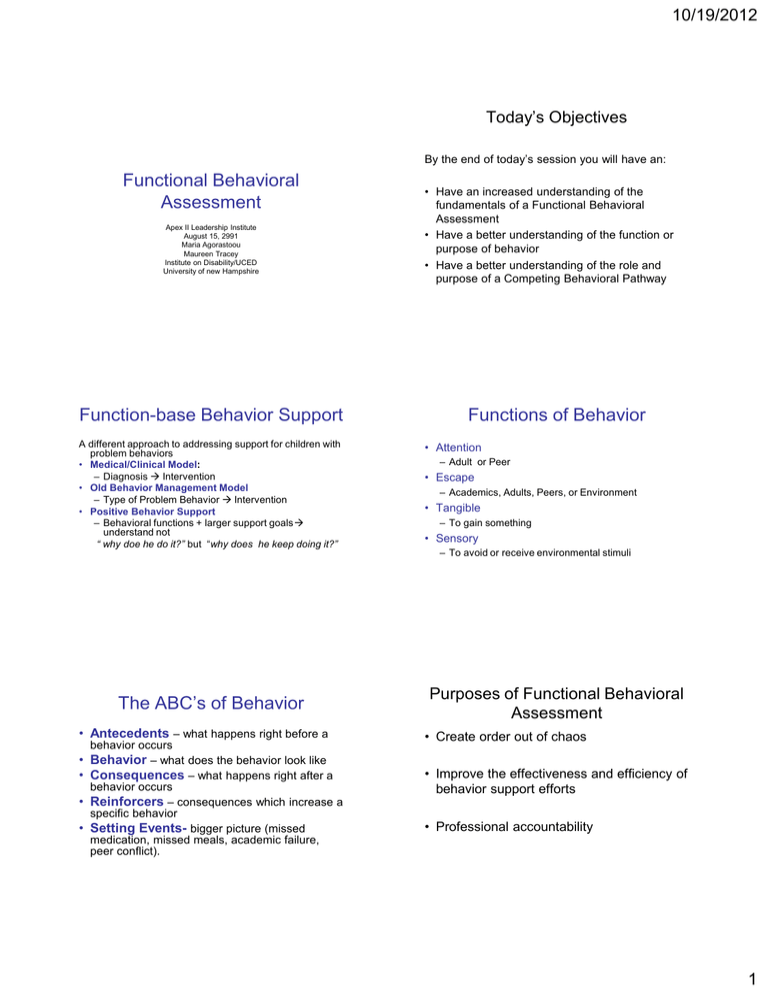
10/19/2012 Today’s Objectives By the end of today’s session you will have an: Functional Behavioral Assessment Apex II Leadership Institute August 15, 2991 Maria Agorastoou Maureen Tracey Institute on Disability/UCED University of new Hampshire Function-base Behavior Support A different approach to addressing support for children with problem behaviors • Medical/Clinical Model: – Diagnosis Intervention • Old Behavior Management Model – Type of Problem Behavior Intervention • Positive Behavior Support – Behavioral functions + larger support goals understand not “ why doe he do it?” but “why does he keep doing it?” The ABC’s of Behavior • Antecedents – what happens right before a behavior occurs • Behavior – what does the behavior look like • Consequences – what happens right after a behavior occurs • Reinforcers – consequences which increase a specific behavior • Setting Events- bigger picture (missed medication, missed meals, academic failure, peer conflict). • Have an increased understanding of the fundamentals of a Functional Behavioral Assessment • Have a better understanding of the function or purpose of behavior • Have a better understanding of the role and purpose of a Competing Behavioral Pathway Functions of Behavior • Attention – Adult or Peer • Escape – Academics, Adults, Peers, or Environment • Tangible – To gain something • Sensory – To avoid or receive environmental stimuli Purposes of Functional Behavioral Assessment • Create order out of chaos • Improve the effectiveness and efficiency of behavior support efforts • Professional accountability 1 10/19/2012 Who is the FBA for? Functional Assessment Horner, 2003 • Functional assessment is a process for identifying the events that reliable predict (antecedents) and maintain (consequences) problem behavior. • For those students who exhibit difficulties despite proactive school-wide prevention efforts • Students needing intervention • Likely to be students with both academic and behavioral difficulties • Typically about 10% of the population When Do We Need an FBA? Why???? • When school-wide data documents academic or behavioral problems that consistently distinguish a student from his peers • When teacher's reports indicate that a student is on the verge of failure, despite school-wide or classroom –wide strategies and procedures • When existing interventions need revisions to increase effectiveness • Forces us to define target behaviors more precisely • Let’s us know if the interventions are working • Ensures consistency of planned intervention techniques • Progress becomes visual Defining the Behavior Definition Should Include: • • • • He never sits in his chair She never has her homework She is always disrespectful to adults He never pays attention • • • • • Who displays the inappropriate behavior What does the specific behavior look like Where does the behavior occur When does the behavior occur How often does the behavior occur 2 10/19/2012 Competing Behavior Pathway Setting Events Triggering Antecedents Desired Behavior Typical Consequences Problem Behavior Consequences Replacement Behavior Maintaining Consequences Setting Events Types of FBA Quick - Competing Behavior Pathway Records review Observation Interview with teacher Comprehensive Records review Observation Interview with teacher Interview parents Interview student Interview specialist and others Steps for Creating Positive Function – Based Support Plans 1. Complete the Competing Pathway Chart 2. Create a Function-Based Summary Statement 3. Identify the Replacement behaviors that meet the function 4. Identify intervention strategies with student strengths and interests in mind 5. Develop a Plan to Monitor Progress 6. Develop and Action Plan to Implement BSP 7. Implement and evaluate the plan. Triggering Antecedents Desired Behavior Typical Consequences Problem Behavior Consequences Replacement Behavior Maintaining Consequences “If you always do what you always did you’ll always get What you always got!” Competing Behavior Pathway Setting Events Triggering Antecedents Desired Behavior Typical Consequences Problem Behavior Consequences Replacement Behavior Maintaining Consequences 3 10/19/2012 Identify the Desired Behavior • The desired behavior is the behavior you want the student to perform given the stimulus condition • Example: - Given seat work task work quietly - Given teacher request initiate - Given taunt from peer turn and walk Replacement Behavior • A replacement behavior is a socially acceptable behavior, taught to the student, that achieves the same function (result) as the problem behavior • An appropriate Replacement behavior: - serves the same function as the problem behavior - is, as, or more effective/efficient then the problem behavior - is socially acceptable - can be learned to criterion in 10 school days The Final Word • It is not fair to exact anyone to exhibit a behavior which has never been taught • The key to changing inappropriate behaviors is replacing them wit appropriate behaviors that serve the same function 4


